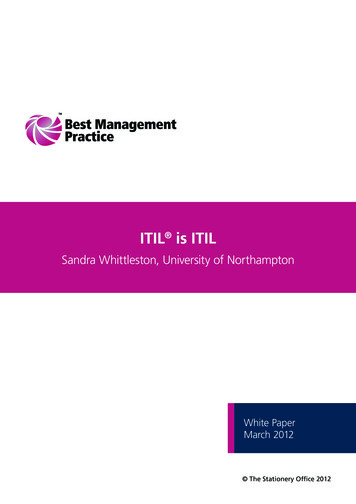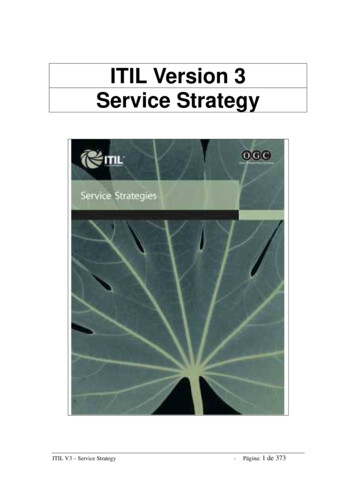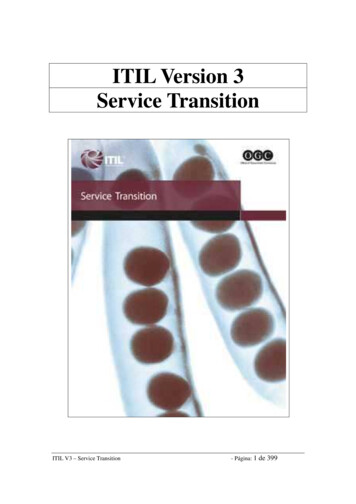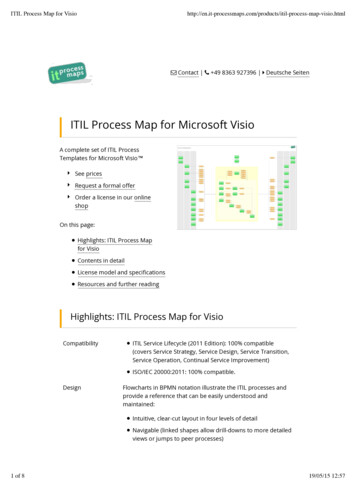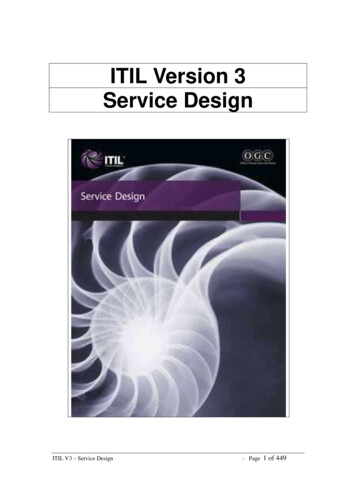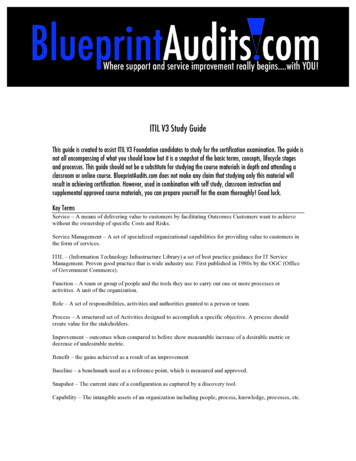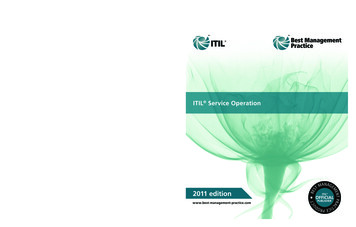
Transcription
S e l f - S t u dy G u id eITIL 4 Specialist:Create, Deliver and SupportITIL 4ITIL is a registered trade mark of AXELOS Limited, used under permissionof AXELOS Limited. All rights reserved.
Copyright and DisclaimerITIL 4 Specialist: Create, Deliver and Support r1.1.0CopyrightCopyright AXELOS Limited 2020. All rights reserved.This is a commercial confidential publication. All rights reserved. This document may not, in a whole orin part, be copied, reproduced, translated, photocopied, or reduced to any medium without prior andexpress written consent from the publisher. This course includes copyrightable work under license andis protected by copyright. No part of this publication may be reproduced, distributed, or transmittedin any form or by any means, including photocopying, recording, or other electronic or mechanicalmethods, without the prior written permission of the publisher, except in the case of brief quotationsembodied in critical reviews and certain other non-commercial uses permitted by copyright law orfurther disseminated without the express and written permission of the legal holder of that particularcopyright. The Publisher reserves the right to revoke that permission at any time. Permission is notgiven for any commercial use or sale of this material.Trade Marks, Source books informationThe content of this book is primarily sourced from the draft version of the AXELOS manuscript forITIL 4 Specialist: Create, Deliver and Support.The content of this course is also sourced from other manuscripts from AXELOS: ITIL Foundation (ITIL 4 edition) ITIL 4 Specialist: Drive Stakeholder Value ITIL 4 Specialist: High Velocity IT ITIL 4 Strategist: Direct, Plan and ImproveITIL is a registered trade mark of AXELOS Limited, used under permission of AXELOS Limited. Allrights reserved.DisclaimerInformation provided about the course, modules, topics and any services for courses includingsimulations or handouts, are an expression of intent only and are not to be taken as a firm offer orundertaking. The Publisher reserves the right to discontinue or vary or maintain such course, modules,topics, or services at any time without notice and to impose limitations on enrolment in any course.The course materials provided may have hypertext links to a number of other web sites as a referenceto users. This service does not mean that the publisher endorses those sites or material on them inany way. The publisher is not responsible for the use of a hypertext link for which a commercial chargeapplies. Individual users are responsible for any charges that their use may incur.The information in this course is written using a blend of British and American English. Although everyeffort has been made regarding the usage of correct spelling, punctuation, vocabulary, and grammarwith regard to the Standard English, publisher accepts no responsibility for any loss or inconveniencecaused due to the regional differences in the usage of the English language.ii Copyright 2020
ContentsAcknowledgements vIntroduction1OverviewITIL 4 Create, Deliver and Support and Service Value ChainKey AudienceITIL 4 Specialist: Create, Deliver and Support CourseCase Study: Axle Car HireExam Details123355Module 1: Organization and Culture7Module ObjectivesIntent and ContextModule TopicsOrganizational StructuresTeam CultureContinual Improvement CultureCollaborative CultureCustomer-Oriented MindsetPositive CommunicationKey Points Covered in the Module7889141921252730Module 2: Effective Teams33Module ObjectivesIntent and ContextModule TopicsCapabilities, Roles and CompetenciesWorkforce PlanningEmployee Satisfaction ManagementResults Based Measuring and ReportingKey Points Covered in the Module3334343440454750Module 3: Information Technology to Create, Deliver and Support Services53Module ObjectivesIntent and ContextModule TopicsIntegration and Data SharingReporting and Advanced AnalyticsCollaboration and WorkflowRobotic Process AutomationArtificial Intelligence and Machine LearningCI/CDInformation ModelKey Points Covered in the Module5354555558616366717476Module 4: Value Streams79Module ObjectivesIntent and ContextModule TopicsAnatomy of a Value StreamDesigning a Value StreamValue Stream MappingKey Points Covered in the Module79798080859094Copyright 2020 iii
Module 5: Value Stream to Create, Deliver and Support ServicesModule ObjectivesIntent and ContextModule TopicValue Stream Model For Creation of A New ServiceKey Points Covered in the Module9595969797117Module 6: Value Stream for User Support119Module ObjectivesIntent and ContextModule TopicsValue Stream Model For Restoration of A Live ServiceKey points Covered in the Module119119120120140Module 7: Prioritize and Manage WorkModule ObjectivesIntent and ContextModule TopicsManaging Queues and BacklogsPrioritizing WorkSwarmingShift-Left ApproachKey Points Covered in the ModuleModule 8: Commercial and Sourcing ConsiderationsModule ObjectivesIntent and ContextKey Terms Covered in the ModuleModule TopicsBuild or BuySourcing ModelsService Integration and ManagementKey Points Covered in the 3169172174Case Study: Axle Car Hire175Exam Preparation Guide181Mock Exam185Appendix A: Answers to Exercises229Appendix B: Purpose of ITIL 4 Practices241Appendix C: Value Stream Templates245Appendix D: Syllabus247Appendix E: Release Notes255Appendix F: Participant Feedback Form257iv Copyright 2020
AcknowledgementsWe would like to sincerely thank the experts who have contributed to the design and development ofthe ITIL 4 Specialist: Create, Deliver and Support course.Design TeamHelen MorrisHelen Morris has over 25 years of experience in service management includingoperational management of services in a variety of industry sectors. Sheholds the ITIL Expert qualification and is an experienced trainer for ITIL. Shehas coauthored a number of study guide publications and distance-learningcourses covering the service management qualifications.Liz GallacherLiz has over 20 years of experience as a consultant and trainer. She hasdesigned improvement initiatives covering many areas of Service Managementfor a variety of organisation, large and small. Liz provides consultancy andtraining services on all aspects of IT Service Management. She achieveddistinction in the ITIL Manager certificate (top 6%), and holds the ITIL Expertcertification.Madhav LakshminarayananMadhav has over 19 years of experience in IT working with major fortune 500companies, manufacturing, IT services, healthcare, higher education, researchand consulting firms in various technical, operational, project managementand people management roles. Madhav is an ITIL Expert, Certified GE SixSigma Green Belt, PMI Project Management Professional, Scrum Master andPMI Agile Certified Practitioner. Madhav has worked with large customers intheir process improvement and operational excellence initiatives.Virginia AraujoVirginia has over 20 years of professional experience in Technologies andInformation Systems. Virginia specializes in Information Security Management,Service Management and Governance, and Project Management She hasworked as an IT Manager, Senior Consultant and an accredited trainer. She isdistinguished by AXELOS Inc. in 2017, as leading woman in ITSM (IT ServiceManagement). She is also distinguished by AXELOS to the project team tolaunch the new major ITIL 4 release launched in February 2019.Marcel FoedererAs an IT Service Management trainer, consultant and line manager with over25 years of experience in IT, Marcel has performed strategic and tacticalassignments in a wide variety of areas. For the ITIL 4 update, Marcel hasbeen part of the ITIL 4 Lead Architect Team and Review Team at AXELOS.Through his association with AXELOS, Marcel comprehends the background,the architecture, and the underlying reasons of the ITIL 4 update.Copyright 2020 v
Self-Study Guide ITIL 4 Specialist: Create, Deliver and SupportContributors and ReviewersA big thanks to the contributors and reviewers for their feedback, suggestion, and inputs.NameE-mail IDAhmed Garbasharif74@gmail.comAmine El Kadiri Boutchichcontact@ekbais.comArichuna Veraarichuna.vera@gmail.comArmando Ibañez Mejíaaibanezmejia@yahoo.comAyodeji Agbalajobideji.agbalajobi@biwdant.comAzhar Khuwajaazhar.khuwaja@yahoo.caBalantrapu Roudrirowdri@dizitiveit.comBruno Gallierbruno.gallier@dpm-services.euCarlos Regaladocaregalado@hawasolutions.comClaudio Schichtclaudio.schicht@gmail.comDaniel Castillodcastillo@innovati.mxDaniel Popapopicadan@yahoo.comFaisal Iqbalmoonit2012@gmail.comFerran Martà Tassierfmarti@articconsultors.comGhulam MoinuddinGhulam.Moinuddin@etssquare.comGirish Mungragirish.mungra@mcb.muHelen Morrishelen.morris@henrygale.co.ukHeng Meng Tanhmtan128@gmail.comHumberto Barroshumberto.barros@me.comHussam Kamal Morsyhkmorsy@hotmail.comImran Saeed Khanimransk@hotmail.comIndira Anandindira.anand@emirates.comJohn Custyjpcgroup@outlook.comJon Morleygoalman2000@hotmail.comJoris Heirmanjoris.heirman@yokosix.comJose Ruivojose.ruivo@qualius.netKiti Sunoyekitikitisunoye@yahoo.comLars Zobbe Mortensenlars@zobbe.orgLiz Gallacherlizgallacher@helix-services.comMadhav Lakshminarayananmadhav 2002@hotmail.comvi Copyright 2020
AcknowledgementsMeenakshi Heptullameenak 007@yahoo.comMehrdad Khadempourmehrdad.khadempour@gmail.comNabil Zine Abidine Ouazzaniz.nabilouazzani@gmail.comNasser El-Houtnasser@smce.orgNichanal Lamsamnichanal@ovthai.comOlivier Sadiotosadiot@yahoo.frPeter de Koepeterdekoe@gmail.comPeter Eberlepeter.eberle@itsmworkshops.comPiya Chiewcharatcpiya@pholsiri.comPrasad Deshpandeprdeshpande@gmail.comPrashant Pokarnaprasant.pokarnaa@gmail.comRami Al-Qassemralqassem@otrain.com.joRamon Nonesramon.nones@gmail.comRaul Diaz Lomelirdiazlomeli@cert-hub.comRene Visserrene.visser@2improve-it.nlRobert Bruce Spechtrbspecht@shaw.caRohinton Dumasiarohinton@rpdumasia.comRony Plevnikrony.plevnik@gmail.comRuangrit RungruangwatRuangrit@gmail.comSandeep Pathaksandyppathak@gmail.comSankarsan Biswassanasu@sankarsan.comSerge Romaric Bassomobassomo@gmail.comSiddharth Pareeksiddharth.pareek@gmail.comSyed Hyder MehdiShmehdi@isqm.inTed Gaughanted@technolava.comVenkata Naresh Kumar Madireddymvenkat27@outlook.comVirginia Araujovirginia.araujo@gmail.comWessam Ayadwessamakza76@gmail.comXavier Vicoxaviervico@gmail.comZhaofeng Wuitiler@126.comCopyright 2020 vii
IntroductionOverviewThe ITIL 4 Specialist: Create, Deliver and Support module is partof the ITIL 4 Managing Professional stream and you need to passthe related certification exam for working towards the ‘ManagingProfessional’ (MP) designation.ITIL 4 Create Deliver and Support covers the integration of a numberof proven areas of what we might know as ‘IT’ areas of work – fromdesign, to build and test, launch, run and support of products andservices.ITIL ManagingProfessional (MP)ITIL SpecialistCreate,Deliver &SupportITIL FoundationBased upon AXELOS ITIL materials. Material is used under licence from AXELOSLimited. All rights reservedCopyright 2020 1
Self-Study Guide ITIL 4 Specialist: Create, Deliver and SupportThe ITIL 4 Specialist: Create, Deliver and Support course providesinformation and guidance across a number of areas that are requiredto build and maintain a broad ‘professional’ portfolio – collaboration,strong and positive culture, integrated teams and employeesatisfaction.This course provides an understanding on how to integrate differentvalue streams and activities to create, deliver, and support IT-enabledproducts and services. It specifically focuses on two value streams:Value stream for a new serviceValue stream for user supportThe course also discusses the techniques to prioritize work andmethods to manage work.ITIL 4 Create, Deliver and Support and Service ValueChainITIL 4 High VelocityIT and Service Value Chain4sitionThe following figure depicts how the Create, Deliver and Supportmodule maps to the ITIL service value chain. The Create, Deliverand Supportalignswith the middlepart of valuechain,Unlike the other modulesof ty IT coabout creating, delivering and supporting services. The servicethe full service valuechain – from demand to value. All aspects and activities of the vavalue activities that are closely associated with Create, Deliver andchain are consideredin HighVelocityIT –&butfrom a Obtain/Builddifferent perspective;Supportmoduleare DesignTransition,and Deliver from theperspective of highvelocity and digitally transformed organization.& Support.Copyright AXELOS Limited 2019. Used under permission of AXELOS Limited. All rights reserved.Copyright AXELOS Limited 2019. Used under permission of AXELOS Limited. Allrights reserved.2 Copyright 2020Cop
IntroductionKey AudienceThe target audience for Create, Deliver and Support includes, but arenot limited to, the following:Service management practitioners involved at any stage ofproduct and service lifecyclesTeam leads and middle management of service providersService and product ownersPeople currently known as process owners and managersProfessionals with following job titles are expected to benefit from thismodule:IT Operations Manager, Availability Manager, Service Desk,Service Managers, Service Architects, Security Manager,Technology Support teams, UX/UI Designer, DevelopmentManagers, Developers, Testers, Infrastructure OperationsEngineer, Software DeveloperProduct owners, Project Managers, Business RelationshipManager, Customer Relationship ManagerITIL 4 Specialist: Create, Deliver and Support CourseOverviewThe ITIL 4 Specialist: Create, Deliver and Support course is based onthe ITIL 4 Specialist: Create, Deliver and Support exam specificationfrom AXELOS. With the help of ITIL 4 concepts and terminology,exercises, and examples included in the course, you will acquirerelevant knowledge to pass the ITIL 4 Specialist: Create, Deliver,and Support certification exam.The ITIL 4 Specialist: Create, Deliver and Support course reflects newways of approaching service management. The course is designedto provide practitioners with both theoretical and practical knowledgeof the ITIL 4 holistic approach to building and modifying technologyenabled services from demand to value. This course describes howvalue streams can be built and managed holistically and how continualimprovement iterations and feedback loops can be included in valuestreams. The course explores areas such as development, testing,knowledge, customer and employee feedback, new technologies,sourcing, and ways of managing work.The course provides guidance on how to collaborate and coordinateefforts to design, build, and support integrated and effective productsand services, building from ITIL Foundation.Copyright 2020 3
Self-Study Guide ITIL 4 Specialist: Create, Deliver and SupportLearning Outcomes Covered in the CourseThe ITIL 4 Specialist: Create, Deliver and Support course coversthe content in relation to the following learning outcomes of the examspecification for ITIL 4 Managing Professional Transition module:1. Understand how to plan and build a service value stream tocreate, deliver, and support services2. Know how relevant ITIL practices contribute to the creation,delivery and support across the SVS and value streams3. Know how to create, deliver and support servicesStructure of the CourseThe ITIL 4 Specialist: Create, Deliver and Support course includes8 modules. These modules can be considered to be part of a logicalstructure comprising three sections:Section 1: Critical Success Factors of ITSM Excellence{{Module 1: Organization and Culture{{Module 2: Effective Teams{{Module 3: Information Technology to Create, Deliver andSupport ServicesSection 2: Value Streams to Create, Deliver and SupportServices{{{{{{Module 4: Value StreamsModule 5: Value Stream to Create, Deliver and SupportServicesModule 6: Value Stream for User SupportSection 3: Managing Work and Sourcing Considerations{{Module 7: Prioritize and Manage Work{{Module 8: Commercial and Sourcing ConsiderationsThe first three modules provide guidance for professionals in IT andservice management to build and maintain a broad professionalportfolio. The content of these three modules relates to organizationalstructures, people, communications, information and technology, andthe importance of being aware of new opportunities. These particularareas are emphasized in ITIL 4 because they are as important forsuccess as processes, practices, and technical knowledge.The next three modules – Module 4 to Module 6 – provide guidanceon understanding how work flows across the organization and howthis flow can be reflected through value streams.The last two modules – Module 7 and 8 - provide guidance aboutstrategies for managing work, techniques for prioritization, andcommercial and sourcing considerations.4 Copyright 2020
IntroductionITIL 4 Specialist Create, Deliver and Support Course (Contd.)Course ComponentsCourse ComponentsCourse ContentDiscussions andActivitiesExample and TipsExamInformationAdditionalComponentsCopyright 2019 12Case Study: Axle Car HireThe case study, Axle Car Hire, is intended to show how an organizationtransforms itself and meet new challenges using the guidanceprovided by ITIL 4 with regard to organizational structures, people,communications, information and technology and value streams.The case study demonstrates how an organization tries to make itsservices as effective as possible, by using the best combination oftheir people, their teams, their technology, their value streams, andtheir ways of working.Driven by Difference.AXLECar HireThe introduction to the case study is provided in the appendix.Exam DetailsBloom Level: 2 and 3Exam Format:{{Close Book format{{Web-based and paper-basedCopyright 2020 5
Self-Study Guide ITIL 4 Specialist: Create, Deliver and SupportQuestions: 40 Multiple Choice Questions (MCQs) of 1 markeachPassing Score: 70% (28 marks out of 40)Exam Duration:{{{{90 minutes25% extra time for non-native English speakers (113 minutesin total)Proctoring: Live/WebcamAfter completing this training, you will be planning to take the ITIL Specialist Create, Deliver, and Support certification exam. To give youan idea about the certification exam, sample paper (or mock exam) isincluded within the course.6 Copyright 2020
1Organization and CultureModule ObjectivesAt the end of this module, you will be able to:Understand the changes in organizational structure and use ofITIL guiding principles to improve the organizational structure.Understand the characteristics of good team culture.Understand the benefits and challenges of of continualimprovement culture.Understand the difference between collaboration andcooperation and their purpose in an organization.Understand the importance of customer-oriented mindset.Understand the importance and principles of goodcommunication.This module is based on the following assessment criteria of the examspecification:Understand the concepts and challenges relating to thefollowing across the service value system:a) Organizational structureb) Integrated/collaborative teamsc) Team culture and differencesd) Working to a customer-orientated mindsete) The value of positive communicationsCopyright 2020 7
Self-Study Guide ITIL 4 Specialist: Create, Deliver and SupportKnow how to plan and manage resources in the service valuesystem:a) Team collaboration and integrationb) The culture of continual improvementIntent and ContextThis module focuses on the key areas required to build effective teamsand collaborative culture.Team e is acritical factor in thecreation, delivery, andsupport of productsand his module focuses on a number of areas that are required to buildeffective team culture that aligns with the organization culture. Cultureis a critical factor in the creation, delivery, and support of productsand services. This module focuses on how to develop and nuturegood team culture and collaborative organizational culture, which issupported by customer orientation and positive communication.Module TopicsOrganizational StructuresTeam CultureContinual Improvement CultureCollaborative CultureCustomer-Oriented MindsetPositive Communication8 Copyright 2020
Module 1 Organization and CultureOrganizational StructuresTraditional Organizational StructuresThere are various types of organizational structures used acrossall organizations. These different organizational structures varysignificantly in approach.Functional Divisional (Geographical) StructureCEONorth alesServicesMatrix StructureCEOMarketingSalesServicesSoft Drinks andJuices DivisionIce-CreamDivisionYummy SnacksDivisionFlat StructureCEOVP AdministrationVP OperationsVarious operations staff (production,purchasing, shipping safety compliance,maintenance)Various administration staff (accounting,marketing, legal, etc.)Copyright 2020 9
Self-Study Guide ITIL 4 Specialist: Create, Deliver and SupportIn order to improve and build effective new ways of working and tosuccessfully drive change and improvement, it is essential to understandhow an organization is structured and how it currently operates. Traditionally,organizational structures have generally been functional and hierarchical innature, with military style lines of command and control. In such structures,a defined leader sits at the top of the organization with various subordinatesand sub levels underneath. Some high-level of examples of structures oforganizations include functional, divisional, matrix, and flat.Functional StructureThe functional structure typically represents hierarchical arrangementsof lines of authority and how work is managed across differentmanagement levels. With this structure, the organization may bedivided into different groups based on functional areas such asmarketing, human resources, and IT.DivisionalOrganizations with divisional structures arrange their activities aroundmarket, product or geographical groups. Each division may have itsfunctional units, such as sales, marketing, electronics and profit andloss accounting.MatrixIn a matrix structure, reporting relationships are set up as a grid ormatrix with pools of people who can move across teams as needed. Inthis structure, the employees often have dual reporting relationships generally to both a functional manager and a product manager.FlatThe flat structure aims to remove hierarchies of authority andmanagement. This structure can be useful to remove barriers of decisionmaking that can slow down progress. However, as organizations growand more teams are required to manage specific responsibilities, thisstructure can become challenging to maintain.The key differences between the various organizational structurescan be described using the following characteristics: Grouping/teaming criteria, such as function, product, territory,or customer. Location, such as co-located or distributed Relationships with value streams, such as responsible for specificactivities or fully responsible for the end-to-end value stream Team members’ responsibility and authority, such as commandand-control or self-driven teams Sourcing of competencies, such as level of integration withteams external to the organizationContemporary Organizational StructuresIn the digital service economy, agility and resilience are vital for anorganization’s success. Organizations must adopt new ways of10 Copyright 2020
Module 1 Organization and Culturestructuring their resources and competencies by following commonapproaches, such as two approaches described here. Faster and more flexible allocation of resources to new or moreimportant tasks. For example, matrix organization structureoften allocate or reallocate resources to different value streams,projects, products, or customers. Permanent, simple multi-competent teams that are assigned towork exclusively on a product. This may result in circumstanceswhen teams are idle, but it ensures a high availability ofresources for the development and management of products.Copyright AXELOS Limited 2019. Used under permission of AXELOS Limited. Allrights reserved.Adoption of flexible and responsive ways of working, such as Agile andDevOps, have led to adoption of new approaches to organizationalstructure, which is more servant and cross-functional. This type ofstructure generally involve applications of matrix and flat structures.Team 1Team 2Team 3Team 4TipsIn order to allow teams to work in across-functional and collaborativefashion, the organization has toalign their goals. This usually meansaligning the organizational structurewith the desired team structure, asobserved by the proverb known asConway’s Law. “Organizations whichdesign systems are constrained toproduce designs which are copies ofthe communication structures of theseorganizations.” – Melvin ConwayCross FunctionalTeam MembersScrum MasterProduct OwnerTesterUI ExpertTech WriterEngineCross DomainDevelopersBased upon AXELOS ITIL materials. Material is used under licence from AXELOSLimited. All rights reservedThe Agile and DevOps approaches requires cross-functional,autonomous teams by applying matrix and flat structures. There is apool of resources that include people with different specialization, whocan be assigned and re-assigned to different teams without delays ofrecruitment, on-boarding and training.It also involves creating cross-functional teams, which can be achievedby applying matrix and flat structures. The formation of organizationalstructure based on cross-functional teams can be a major change andmay involve challenges as this requires an organization to transition fromfunctional and hierarchical models of working to a more fluid and in somecases potentially conflicting areas of responsibility and management.Copyright 2020 11
Self-Study Guide ITIL 4 Specialist: Create, Deliver and SupportThink About ItAdoption of Agile or DevOps TeamsFocus: In order to adapt to more flexible and responsive waysof working, such as agile and DevOps, many organizationshave adjusted their organizational structure.Has your organization adopted the organization structurebased Agile or DevOps Teams? How has this adoption affectedthe organization structure?What are the advantages and disadvantages of organizationstructure with cross-functional, autonomous teams?Axle Car Hire ExampleCase Study Example: Cross-Functional TeamsHenri: At Axle Car Hire, we focus on developing cross-functional teams to develop or modifyproducts and services. This helps to gather requirements from the different functional areas atthe same time. For the biometric technology, Su suggested to introduce biometric technology toidentify our customers. Marco suggested the use of fingerprint or facial recognition scans to quicklyidentify our customers and automate the car collection and return process. Radhika suggestedabout considerations for regulations such as GDPR and risks to data security.Cross-functional teams enables collaboration to define, design, and deliver new features. Team memberswould learn of the new services at the same time and would begin working on estimates together.Servant LeadershipServant leadership is a model where managers support people incross functional teams to achieve organizational goals.The servant leadership style of leadership is based on two key principles: Managers are there to meet the needs of the organization, firstand foremost (not just their individual teams). Managers are there to ‘serve’ and support the people workingfor them by ensuring that they have the relevant resources andorganizational support to get their jobs done.Copyright AXELOS Limited 2019. Used under permission of AXELOS Limited. Allrights reserved.Servant leadership can often be seen in flat, matrix, or productfocused organizations. However, this approach can be applied toany organizational structure. The servant style of leadership inspiresindividuals to collaborate with the leader to become more cohesive andproductive. The servant leadership style inspires teams to collaborate andutilize the help of the leader to become more cohesive and productive.12 Copyright 2020
Module 1 Organization and CultureUsing ITIL Guiding Principles to Improve the OrganizationalStructure“If you’re thinking of moving to a cross-functional servant model,use the ITIL guiding principles to help you decide. This will involvemajor organizational and cultural change.”The ITIL 4 guiding principles are a useful reference point whenplanning to change and improve the organizational structure.Guiding PrincipleConsiderations to Improve Organizational StructureFocus on valueEnsure that the key driver for changing the way of working isreviewed and referenced during each stage of the transformation.Progress iteratively withfeedbackEnsure that the transition/transformation is simplified intomanageable steps.Start where you areConsider the cultural aspects and current roles and responsibilitiesof the organization. For example:Collaborate and promotevisibility Consider the relative maturity and understanding of theorganizational structures in relation to the current organization. Use value stream mapping and a RACI matrix to understandthe organization’s current roles and responsibilities.Ensure that all stakeholders are engaged throughout the changeprocess. Adopt a ‘disagree and commit’ approach to involve everystakeholder to discuss concerns and disagreements.Ensure leaders are easily accessible by adopting an ‘open door’policy.Organizational changes must be clearly defined and openlydiscussed in order to enable tran
the ITIL 4 Specialist: Create, Deliver and Support course. Design Team helen Morris Helen Morris has over 25 years of experience in service management including operational management of services in a variety of industry sectors. She holds the ITIL Expert qualification and

